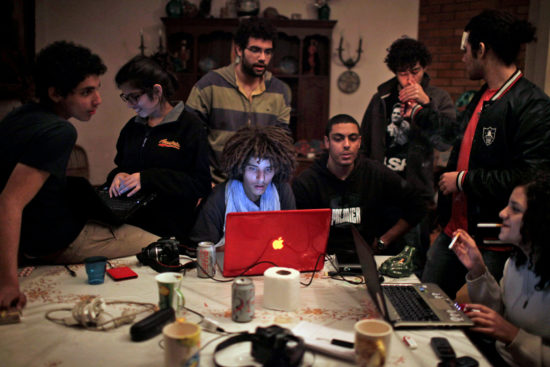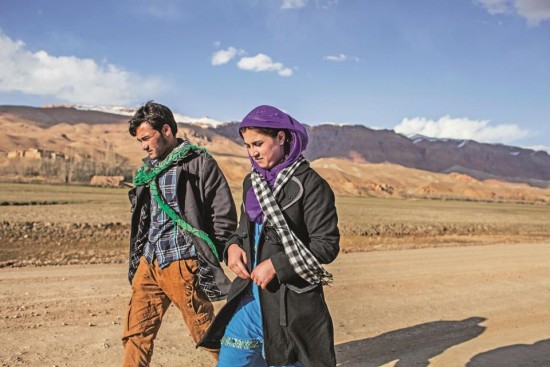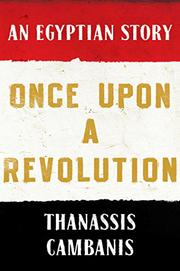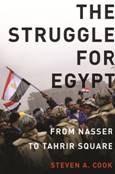SOMETIME IN THE SUMMER of 2011, I was sitting with a few friends at a café on the edge of a cliff overlooking Cairo. We were smoking shisha and drinking tea and beer, watching the sun set over the taupe tableau when we spotted two tall, blond men on the other side of the terrace with a digital camera, filming the sun’s descent through the smog. After a little while, I decided to make conversation. In thick Dutch accents they explained what they were doing: They wanted to film the sunrise over Cairo but, because it was too early in the morning and they only had a limited time in Egypt to shoot, they were filming the sunset instead, which they would play backward. They were making a documentary about the Egyptian revolution.
In the year after the Tahrir uprising that took place in January and February 2011, Cairo was crawling with good-natured documentarians. Having watched the inspiring 18-day “Arab Spring” revolution on television, they clamored to come see the action themselves, and maybe get a taste of the utopia and possibility that was Tahrir Square. Dutch filmmakers on shoestring budgets weren’t the only ones, of course. American anarchists, British journalists, French photographers all wanted a piece of what was going on in Egypt. Many of them left shortly after, taking with them their short films, their articles, blog posts, and think pieces, glorifying the revolution and telling the world that radical political change could be more than just a dream. Egypt had a perfect revolution: horizontal, spontaneous, inspiring. A radical’s fairy tale — or so it seemed.
Some observers stayed longer. Thanassis Cambanis watched not only the sunrise but also the sunset. The product is his book Once Upon a Revolution: An Egyptian Story, a comprehensive, straightforward — and sympathetic — accounting of the Egyptian revolution from its percolations in the anti-police brutality movement that began in Cairo and Alexandria in the summer of 2011 up through the brutal start of General Abdel Fattah el-Sisi’s presidency, making stops along the way to various elections, constitutions, and protests.
Once Upon a Revolution provides a detailed timeline for people with a keen interest in the sequence of events in Egypt in the early years after the Tahrir uprising: the book is a methodical, unforgiving, nearly day-by-day account of mismanaged political parties, state repression, chaos, and fear. But it is more than just a primer. Whether Cambanis intended it or not, his book practically reads as a manual — a cautionary and instructive tale that should be required reading for would-be revolutionaries everywhere, Wall Street Occupiers and Hong Kong umbrella-holders alike, on the extent to which the powerful will go to prevent change and the pitfalls of decentralized revolutionary movements.
The book is loosely centered on two characters, both committed revolutionaries. Basem Kamel is a secular liberal, a middle-class architect with a family, living on the outskirts of Cairo. Moaz Abdelkarim is an idiosyncratic Islamist, a poorly dressed and perpetually tardy pharmacist who makes friends with the leftists and liberals in the tent camps in Tahrir Square during the 18-day “Arab Spring” uprising and eventually breaks with the Muslim Brotherhood over its exclusivist policies. They serve as imperfect stand-ins for the main strains of the Egyptian opposition and, over the course of the book, they become familiar if never truly deep characters. It’s the story of the revolution itself that drives Once Upon a Revolution’s narrative along.
Anyone who follows news from the Middle East knows the horrific ending (at least for now) to the story. Today, in Egypt, revolutionaries are jailed while officials from the former regime run for parliament. To understand how the country got from that to this, it helps to dwell a bit in the details, in the small missteps and sown chaos that took place between February 11, 2012, when President Hosni Mubarak stepped down, and August 14, 2013, the date when the army murdered some 600 Muslim Brotherhood supporters and began a crackdown that lasts until today. That’s precisely what Cambanis does, and the results are useful.
After the initial protests forced President Hosni Mubarak from power, a military junta known as the Supreme Council of Armed Forces (SCAF) took control of Egypt. The generals vociferously claimed they were the defenders of the revolution, but they did everything in their power to stymy radical change. They fast-tracked constitutions and dissolved parliaments, they cut backroom deals and initiated prosecutions. Most of all, they sowed fear and chaos that ultimately served them perfectly.
Once Upon a Revolution devotes an entire chapter to the night of October 9, 2011, and the days afterward. That evening, a protest of Coptic Christians demanding equal rights marched from a north Cairo neighborhood to the headquarters of the state media, known as Maspero. The march was met with unexpected brutality: Armored personnel carriers barreled into unarmed protesters. Military police fired live bullets into the crowd. Twenty-eight died. Reports emerged of the army tossing bodies into the nearby Nile. That night, Egyptian state media spewed sectarian incitement against the Christian minority community. In the aftermath, the generals made pitiful attempts to spin the facts: the Copts had killed each other, the APC’s collision course was an accident.
At the time, the impact of the massacre wasn’t even completely evident to Egyptians themselves, much less outside observers. Cambanis writes, “In the weeks that followed the massacre, Egypt went about business as usual. The organized political class rallied the cadres. Maspero hardly affected the calculations of the SCAF, the Wafd Party, the Brothers, and the Salafis.” On the surface that’s true, but the effect was more subtle and more profound. The Maspero massacre — along with the police’s repeated crushing of anti-SCAF protests and even the February 2012 soccer riot in Port Said that left more than 70 people dead — became part of a patchwork of violence that created a climate of instability, fear, and paranoia. Compared with Mubarak’s resignation or the July 3, 2013 military coup, the Maspero massacre may appear a minor sideshow. And yet these events — whether they were at the behest of the SCAF or not we may never know — helped lay the groundwork for the military’s takeover.
But the military wouldn’t have been able to launch its power grab had it not been for political conditions on the ground, something on which Cambanis keeps an equally close eye. Recounting the opposition’s incompetence is just as crucial for understanding why Sisi’s retrenchment was possible. The Muslim Brotherhood deserves perhaps as much blame as the military for the revolution’s failure to achieve its goals. The group was famously Egypt’s best-organized political organization and one of the few actors with enough clout to negotiate with the military. It did so repeatedly and in the process betrayed the fundamental aims of the revolution. The Brotherhood leadership cut deals with the army to bring itself to power, as when it backed the SCAF-written constitution and helped push forward premature elections.
The Brotherhood’s politicking succeeded — for a time. Mohamed Morsi, the Brotherhood candidate, won the 2012 presidential election. But the Islamists’ missteps and overreaches helped turn Egyptians away from the democratic experiment and, in the end, straight back into the army’s waiting hands. Cambanis’s chapter on Morsi’s rule is titled “The Enemy Within.” It recounts exactly what the Brotherhood did to make its sometimes-allies, the revolutionaries, so completely distrustful: cutting deals with the SCAF and standing by the military and police while they cracked down on anti-government protests. By the summer of 2012, when Morsi became the president, the Brotherhood had no credibility. Morsi’s rule only undermined it further, seemingly proving everyone’s worst fears by proposing banning alcohol to issuing a radical decree in November 2012 that gave himself nearly unlimited powers as president over the judiciary and the constitution-writing process.
It was more or less inevitable that the anti-authoritarians would join forces with the anti-Islamist reactionaries to oppose Morsi. Many among the revolutionaries — including the social democrat Basem, one of Cambanis’s protagonists — backed a June 30, 2013 protest calling for Morsi’s removal. Three days later, the anti-Morsi protests culminated with a military takeover.
The revolutionaries — the leftists and liberals who formed the core of the uprising and tried to keep its goals alive amid military massacres and Brotherhood backroom dealing — do not emerge blameless from the tumultuous 2011–2013 period. Cambanis is unabashedly sympathetic to them. (I was, and am, too.) But he can’t help but point out their foibles. The revolutionaries failed to take advantage of electoral politics; they neglected political organizing in the countryside and the small cities in favor of Cairo and Alexandria (and Tahrir Square in particular); they made demands on the government that were at times unreasonable; they squandered opportunities to have their voices heard by those who held power; far too often they fought among themselves. (Something that some — such as the Revolutionary Youth Coalition, of which Moaz, one of Cambanis’s central characters, was a member — came to admit only too late.)
Nothing exemplifies the revolutionaries’ pitfalls and failures as well as the ill-fated Tahrir Square sit-in of July 2011. Amid feelings that the revolution had stalled under military rule, the revolutionary groups repaired to their favorite tactic: a tent camp in the center of Cairo. But unlike the initial uprising demanding Mubarak leave the presidency, this time the goals were diffuse and hazy. Protesters called for prosecution of members of the former regime, including hanging Mubarak, but other arguments were presented poorly. The protesters gathered under the conveniently ambiguous slogan “The Revolution First.” Once they were stuck in the square — in the sweltering weather of Cairo in July — they couldn’t back down. Each group was concerned about looking somehow less revolutionary than the others. The sit-in lacked public support and petered out. The memory of the July sit-in, like so much from that decisive year, will likely wither into oblivion. It was one of many missteps. But by focusing a chapter around it (“Stuck in the Square”), by describing the way the revolutionaries argued among themselves and aimlessly checked social media on their iPhones from the center of Tahrir, Cambanis makes clear what exactly went wrong, giving a microcosmic preview of the ways the revolution would falter. Every political organizing meeting in Cairo that devolved into pointless bickering under a cloud of cigarette smoke feels like a tragic missed connection — what if that one had only worked out?
Maybe those are lessons that can be learned for the next time around. Cambanis ends his book discussing the possibility of the revolution continuing in some form, at some point in the future. “The revolution continues,” was a common slogan during the years covered in the book, it was spray painted on walls, uttered in conversations, chanted at protests. It was even the name of a short-lived political party. It’s a hard mantra to keep alive these days. But optimism in itself can be revolutionary. President Sisi’s rule won’t last forever. And when the revolution continues — Egypt’s or any of the many uprisings that Tahrir inspired — a close reading of the history of Egypt from 2011 to 2013 could help the revolutionaries understand how to move forward.
That history shows the lengths to which entrenched elites will go to hold on to power: how they will manipulate, obfuscate, censor, and squash the opposition. At the same time, this recent history demonstrates for would-be revolutionaries the importance not just of learning how to protest and break down structures of power, but how new ones must be built from the ground up. The start of Egypt’s revolution was telegenic and inspiring; its demise, for now, at the hands of General Sisi has been hideous and demoralizing. But it’s important to know what happens between the sunrise and the sunset.
¤
Max Strasser is an associate editor at Foreign Policy magazine.




 That Cairo landmark is a metonym. As journalist/historian Cambanis (A Privilege to Die: Inside Hezbollah’s Legions and Their Endless War Against Israel, 2010) records in this lucid account of the Egyptian uprising, strategists of the opposition spent much time figuring out just where they could organize protests without being quashed by the country’s well-organized military, setting some of the early demonstrations and meetings in places “where the streets were too narrow for police trucks and water cannons” until momentum grew. It didn’t take long for the revolt to sweep the country, with its crowning day on Jan. 25, 2011. Cambanis profiles ordinary Egyptians who rose up against the Mubarak regime, some out of support for the Islamist cause, others in the hope of secular democracy. Their political divide runs deep. As the author writes of one key actor, “El-Shater didn’t seem to understand how much the liberals hated the Islamists, and how much the revolutionary Islamist youth mistrusted the Brotherhood leadership, himself included.” It is for that reason that the revolution—which, Cambanis reminds us, necessarily involves tumult and violence—remains incomplete. “I fell in love with the Tahrir Revolution,” he writes, “but this love didn’t blind me to its faults.” Still, to judge by this account, those faults are fewer than those of the previous regime, which leaves some hope that the people of Egypt are headed in the right direction—even if the Muslim Brotherhood soon “exposed itself as power hungry and eager to use violent tools of repression to silence opponents.”
That Cairo landmark is a metonym. As journalist/historian Cambanis (A Privilege to Die: Inside Hezbollah’s Legions and Their Endless War Against Israel, 2010) records in this lucid account of the Egyptian uprising, strategists of the opposition spent much time figuring out just where they could organize protests without being quashed by the country’s well-organized military, setting some of the early demonstrations and meetings in places “where the streets were too narrow for police trucks and water cannons” until momentum grew. It didn’t take long for the revolt to sweep the country, with its crowning day on Jan. 25, 2011. Cambanis profiles ordinary Egyptians who rose up against the Mubarak regime, some out of support for the Islamist cause, others in the hope of secular democracy. Their political divide runs deep. As the author writes of one key actor, “El-Shater didn’t seem to understand how much the liberals hated the Islamists, and how much the revolutionary Islamist youth mistrusted the Brotherhood leadership, himself included.” It is for that reason that the revolution—which, Cambanis reminds us, necessarily involves tumult and violence—remains incomplete. “I fell in love with the Tahrir Revolution,” he writes, “but this love didn’t blind me to its faults.” Still, to judge by this account, those faults are fewer than those of the previous regime, which leaves some hope that the people of Egypt are headed in the right direction—even if the Muslim Brotherhood soon “exposed itself as power hungry and eager to use violent tools of repression to silence opponents.”



